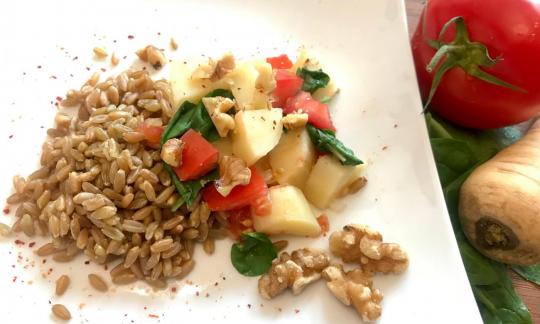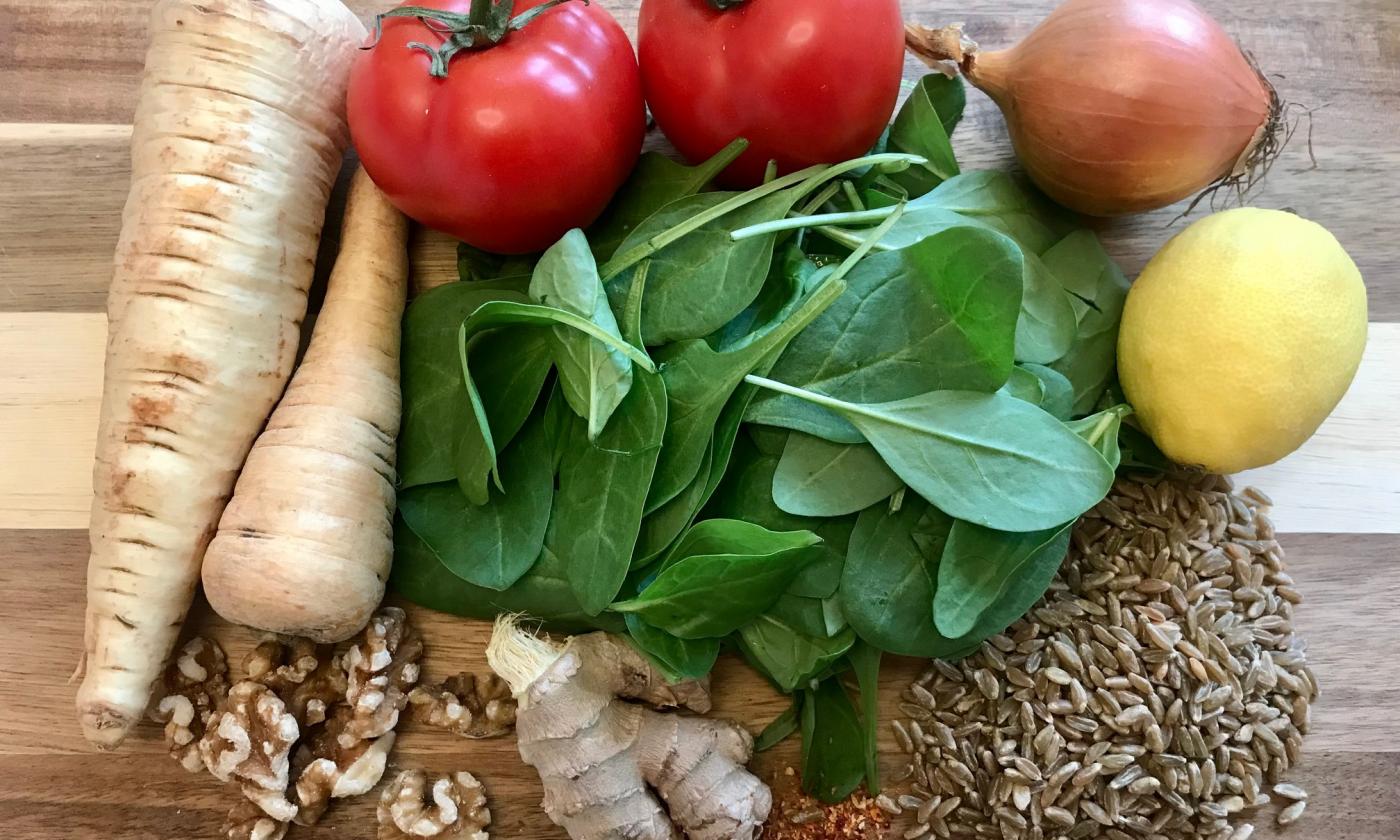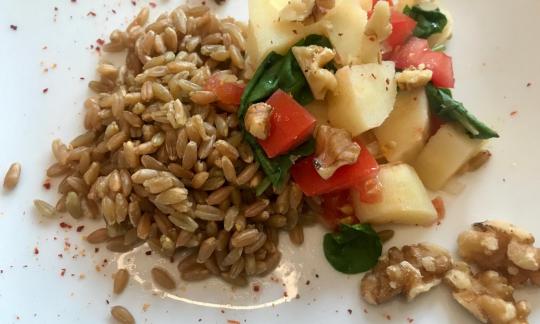Parsnip-Spinach Vegetables with Walnuts on Green Spelt
vegan
Ingredients (for servings, )
| For the green spelt | |
|---|---|
| 3 ½ oz | Green spelt, raw grains? (organic?) |
| 200 ml | Drinking water, raw (organic?) (7.0 oz) |
| For the vegetables | |
| ½ | Onions, raw (organic?) (1.9 oz) |
| 2 cm | Ginger, raw (organic?) (0.76 oz) |
| 11 oz | Parsnips, raw (organic?) |
| 2 | Tomatoes, raw (organic?) (8.6 oz) |
| 3 ½ oz | Spinach, raw (vegetable spinach) |
| ⅓ oz | Walnuts (tree nuts), raw (organic?) |
| To refine | |
| 1 tsp | Chili flakes (raw?, organic?) (0.16 oz) |
| 1 dash | Table salt (table salt, raw?, organic?) (0.01 oz) |
| ½ | Lemons, raw (limes, organic?) (1.0 oz) |
Equipment
- grater
- vegetable peeler
- skillet (frying pan)
- stove
- saucepan
- sieve
Type of preparation
- cook
- chop or grind
- sweat
- meld
- season to taste
- remove the skin
- peel
- grate (shred)
- drain
Preparation
For the green spelt
Put the green spelt in a pot with water and bring to the boil. Add a little salt to the water if necessary. Simmer the green spelt for about 15 minutes. Then remove from the heat and leave to simmer with the lid on.In the meantime, continue with the vegetables.
Change the side dish: Instead of green spelt, you can also use whole grain rice or quinoa.
For the vegetables
Peel the onions and dice finely. Peel the ginger and grate finely. Peel the parsnips, halve them lengthways and cut into half a cm thick slices. Halve the slices again to make quarters (if the parsnips are thick, cut them into thirds instead of halving). Wash the tomatoes and cut into cubes. Wash the spinach and drain. Roughly chop the walnuts.Chopping walnuts: You can wrap the nuts in a cloth and work them with a solid object (e.g. hammer) on a solid surface.
Swiss chard instead of spinach: Both the stems and the leaves of Swiss chard are edible.
Put the onions and ginger in a non-stick pan and sweat with 1-2 tablespoons of water. Stir occasionally. Add the parsnips and about 100 ml of water and simmer for 5 minutes (if it starts to stick, add a little more water). Add the tomatoes and simmer for another 2-3 minutes. Add the spinach and leave to simmer for 2-3 minutes with the lid closed.
finishing and serving
Season the vegetables with chili, salt and a dash of lemon.
Divide the kale between plates, arrange the vegetables on top and sprinkle with chopped walnuts.
|
Nutritional Information per person
Convert per 100g
|
2000 kcal | |
|---|---|---|
| Energy | 383 kcal | 19.2% |
| Fat/Lipids | 5.8 g | 8.3% |
| Saturated Fats | 0.70 g | 3.5% |
| Carbohydrates (inc.dietary fiber) | 78 g | 29.0% |
| Sugars | 14 g | 15.3% |
| Fiber | 17 g | 67.8% |
| Protein/Albumin | 12 g | 23.5% |
| Cooking Salt (Na:148.6 mg) | 377 mg | 15.7% |
| Essential micronutrients with the highest proportions | per person | 2000 kcal | |
|---|---|---|---|
| Vit | Vitamin K | 288 µg | 383.0% |
| Min | Manganese, Mn | 3.2 mg | 159.0% |
| Vit | Vitamin B9, B11 (Folate, as the active form of folic acid) | 255 µg | 128.0% |
| Vit | Vitamin C (ascorbic acid) | 67 mg | 84.0% |
| Elem | Potassium, K | 1'525 mg | 76.0% |
| Min | Copper, Cu | 0.58 mg | 58.0% |
| Elem | Phosphorus, P | 401 mg | 57.0% |
| Elem | Magnesium, Mg | 181 mg | 48.0% |
| Vit | Vitamin B6 (pyridoxine) | 0.59 mg | 42.0% |
| Prot | Tryptophan (Trp, W) | 0.10 g | 41.0% |
Detailed Nutritional Information per Person for this Recipe
The majority of the nutritional information comes from the USDA (US Department of Agriculture). This means that the information for natural products is often incomplete or only given within broader categories, whereas in most cases products made from these have more complete information displayed.
If we take flaxseed, for example, the important essential amino acid ALA (omega-3) is only included in an overarching category whereas for flaxseed oil ALA is listed specifically. In time, we will be able to change this, but it will require a lot of work. An “i” appears behind ingredients that have been adjusted and an explanation appears when you hover over this symbol.
For Erb Muesli, the original calculations resulted in 48 % of the daily requirement of ALA — but with the correction, we see that the muesli actually covers >100 % of the necessary recommendation for the omega-3 fatty acid ALA. Our goal is to eventually be able to compare the nutritional value of our recipes with those that are used in conventional western lifestyles.
| Essential fatty acids | per person | 2000 kcal |
|---|---|---|
| Alpha-Linolenic acid; ALA; 18:3 omega-3 | 0.58 g | 29.0% |
| Linoleic acid; LA; 18:2 omega-6 | 2.8 g | 28.0% |
| Essential amino acids | per person | 2000 kcal |
|---|---|---|
| Tryptophan (Trp, W) | 0.10 g | 41.0% |
| Threonine (Thr, T, irreversibly transaminated) | 0.31 g | 34.0% |
| Isoleucine (Ile, I) | 0.37 g | 30.0% |
| Phenylalanine (Phe, F) | 0.42 g | 27.0% |
| Leucine (Leu, L) | 0.62 g | 26.0% |
| Valin (Val, V) | 0.43 g | 26.0% |
| Lysine (Lys, K, irreversibly transaminated) | 0.33 g | 18.0% |
| Methionine (Met, M) | 0.14 g | 15.0% |
| Vitamins | per person | 2000 kcal |
|---|---|---|
| Vitamin K | 288 µg | 383.0% |
| Vitamin B9, B11 (Folate, as the active form of folic acid) | 255 µg | 128.0% |
| Vitamin C (ascorbic acid) | 67 mg | 84.0% |
| Vitamin B6 (pyridoxine) | 0.59 mg | 42.0% |
| Vitamin A, as RAE | 316 µg | 40.0% |
| Vitamin B1 (Thiamine) | 0.41 mg | 37.0% |
| Vitamin E, as a-TEs | 4.2 mg | 35.0% |
| Vitamin B5 (Pantothenic acid) | 1.8 mg | 30.0% |
| Vitamin B7 (Biotin, ex vitamin H) | 14 µg | 29.0% |
| Vitamin B3 (Niacin) | 4.2 mg | 27.0% |
| Vitamin B2 (Riboflavin) | 0.29 mg | 21.0% |
| Essential macroelements (macronutrients) | per person | 2000 kcal |
|---|---|---|
| Potassium, K | 1'525 mg | 76.0% |
| Phosphorus, P | 401 mg | 57.0% |
| Magnesium, Mg | 181 mg | 48.0% |
| Sodium, Na | 149 mg | 19.0% |
| Calcium, Ca | 148 mg | 18.0% |
| Essential trace elements (micronutrients) | per person | 2000 kcal |
|---|---|---|
| Manganese, Mn | 3.2 mg | 159.0% |
| Copper, Cu | 0.58 mg | 58.0% |
| Iron, Fe | 5.2 mg | 37.0% |
| Zinc, Zn | 3.4 mg | 34.0% |
| Selenium, Se | 3.8 µg | 7.0% |
| Iod, I (Jod, J) | 8.9 µg | 6.0% |
| Fluorine, F | 104 µg | 3.0% |
The parsnip-spinach vegetables with walnuts and green spelt are easy to prepare and contain many important essential nutrients.
Nutrient profile: According to GDA guidelines, one portion of this recipe covers several times the average daily requirement of vitamin K. In addition, it covers over 100% of the daily requirement of manganese and the essential folic acid. Vitamin C is also almost 100% covered. The ratio of omega-6 to omega-3 fatty acids is 5:1, within the recommended maximum ratio.
Read more at: Vegans often eat unhealthily. Avoidable nutritional errors .
Parsnips: The roots, which are mainly harvested in winter, have a sweet and spicy taste, sometimes even bitter. They taste like carrots and celery and are also similar to parsley root, but milder. Parsnips not only stimulate the appetite, but also have a diuretic effect. Compared to carrots, parsnips contain a much higher content of fiber, potassium, protein and vitamin C.
Spinach: Spinach is rich in vitamins (especially vitamin K, folic acid, vitamin A and vitamin C), protein and minerals. Although spinach has a high iron content among vegetables, the iron content is not exceptionally high. Despite the high oxalic acid content, consuming raw spinach in reasonable amounts is not harmful to health.
Green spelt: Green spelt is made from spelt, a relative of wheat. The ingredients are comparable to those of wheat, with the exception that the silica content is significantly higher. Like wheat, green spelt contains gluten, which can cause health problems in people with celiac disease (gluten intolerance).
Ginger: Ginger is aromatic and has a sharp, spicy taste that is due to the pungent compound gingerol, a substance with anti-carcinogenic and anti-inflammatory properties. As a cooking ingredient, ginger root is used in various forms, including fresh, dried and ground.
Recommended consumption of spinach: Spinach should not be stored at room temperature for long periods (around a week). Spinach contains a lot of nitrate, which bacteria convert into harmful nitrite. This can cause problems, especially in children, as it impairs the transport of oxygen in the body and the effects depend on both the amount consumed and body weight.
There are also 'fresh', packaged spinach leaves in plastic bags. However, the industry has to treat these heavily to ensure that they last longer, as germs multiply quickly under the plastic. Vitamins also last less time than in really fresh spinach.
Chopping walnuts: You can wrap the nuts in a cloth and work them with a solid object (e.g. hammer) on a solid surface.
Reduce salt and oil: We have consciously reduced salt and left out oil for health reasons. You can find more information on this topic in our book, which we describe in detail: "Salt Sugar Fat" by Michael Moss.
Swiss chard instead of spinach: Both the stalks and the leaves of Swiss chard are edible. It tastes like spinach, but is more intense and bitter. Swiss chard contains a lot of vitamin K, but also vitamin C, vitamin A and vitamin E, as well as sodium, magnesium, potassium and iron. Like spinach, Swiss chard has a high oxalic acid content.
Change the side dish: Instead of green spelt, you can also use whole grain rice or quinoa.








